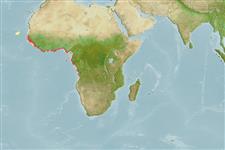Environment: milieu / climate zone / depth range / distribution range
Ecology
Marine; freshwater; brackish; demersal; depth range 0 - 50 m (Ref. 2683). Tropical; 21°N - 18°S, 26°W - 20°E
Eastern Atlantic: Senegal to Angola (Ref. 5979, 81290, 81683). Also reported from Mauritania (Ref. 55783).
Size / Weight / Age
Maturity: Lm ? range ? - ? cm
Max length : 17.6 cm TL male/unsexed; (Ref. 128374)
Dorsal
spines
(total): 0;
Dorsal
soft rays
(total): 80-87;
Anal
spines: 0;
Anal
soft rays: 59 - 65. Diagnosis: body oval, its depth 45-50% SL (Ref. 81290, 81683). Head length 27-31% SL; eye diameter 16-23% HL; teeth in a single row on upper as well as lower jaw, no caniniform teeth (Ref. 81683). Interorbital space narrow and slightly concave (Ref. 81290, 81683). Hind end of maxilla extending to below centre of eye (Ref. 81290, 81683) but never posterior to posterior edge of pupil (Ref. 81683). Fin base length of both pelvic fins short and of about equal length (Ref. 81683). Body covered with cycloid or weakly ctenoid scales (Ref. 81290, 81683). Gill rakers moderately long and slender (Ref. 81290, 81683), about 2/3-3/4 length of gill filaments at angle of gill arch (Ref. 81683).
Coloration: eyed side yellowish brown with dark spots along dorsal and anal fins; dark brown spot at base of caudal fin, as well as on upper and lower caudal fin rays; dorsal and anal fins with a series of dark brown spots; blind side entirely whitish (Ref. 81620, 81683).
Occurs in coastal waters (Ref. 2683, 81290) and brackish water of estuaries and lagoons (Ref. 81290, 81683), also ascending rivers (Ref. 81683) and entering freshwater (Ref. 2683). Feeds on fish, shrimps and crabs (Ref. 28587).
Life cycle and mating behavior
Maturity | Reproduction | Spawning | Eggs | Fecundity | Larvae
Distinct pairing (Ref. 205). Oviparous (Ref. 101737). Females produce numerous eggs in multiple spawnings during a prolonged spawning period (Ref. 101737).
Aldebert, Y., M. Desoutter and J.-C. Quéro, 1990. Bothidae. p. 1027-1036. In J.C. Quero, J.C. Hureau, C. Karrer, A. Post and L. Saldanha (eds.) Check-list of the fishes of the eastern tropical Atlantic (CLOFETA). JNICT, Lisbon; SEI, Paris; and UNESCO, Paris. Vol. 2. (Ref. 5979)
IUCN Red List Status (Ref. 130435)
Threat to humans
Harmless
Human uses
Fisheries: commercial
More information
ReferencesAquacultureAquaculture profileStrainsGeneticsElectrophoresesHeritabilityDiseasesProcessingNutrientsMass conversion
Tools
Warning: mysqli::__construct(): (HY000/1040): Too many connections in /var/www/html/includes/speciessummary.lib.php on line 2414
Can't connect to MySQL database fbquizv2. Errorcode: Too many connections
